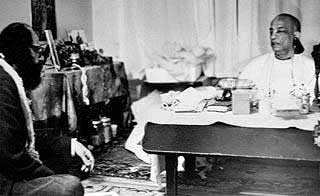“Śrīla Prabhupāda’s Kīrtana Standards,” installment 18

Our standard way of kīrtana is “call and response.” In a conversation with Allen Ginsberg about an upcoming program at Ohio State University, Śrīla Prabhupāda said, “Responsive chanting must be there. . . . Otherwise, everyone will become tired, and that will be chaotic. Response. That’s nice. Then the audience will respond.”1
Similarly, Śrīla Prabhupāda wrote to Haṁsadūta and Himavatī:
Responsive chanting is very nice; one good singer may lead, and the others may join in. That is the system in India. It is very good for two reasons especially: One, the chanter gets to rest, so he does not become tired, and two, you get to chant and hear, that is the process.2
And again to Haṁsadūta the next day:
[T]he responsive method is all perfect. I have already written you in my last letter in this connection, and again I say that the responsive method should be practiced. There may be more than one singer, just like you may take the leader’s seat, sometimes Jaya Govinda may take the leader’s seat, sometimes others may take the leader’s seat, but the method of chanting and responding, then chanting, should always be followed.3
Similarly, to Śyāmasundara Dāsa:
My special instruction to you all is that you practice Sankirtana very rhythmically and in a responsive way. That means one should chant first, and others should follow him. That is a very nice system.4
Yet on another occasion Śrīla Prabhupāda wrote:
Regarding responsive chanting, that is the preferred method, but if you think it will be better to chant nonresponsively at certain times, there is no harm. If you think that people will chant more if you do it non-responsively, then do it that way. It is the chanting that is required. But if it is done responsively, it will sound symmetrical and will appeal to the people.5
In an exchange following a lecture in Los Angeles in 1968, Śrīla Prabhupāda first sheds light on how to meditate while chanting and then speaks of responsive chanting:
Devotee [repeating a question by someone else]: What do you think about when you’re chanting?
Prabhupāda: Chanting? You simply hear. When you say “Hare Kṛṣṇa,” you try to hear the very sound, “Hare Kṛṣṇa.” That’s all. Nothing more. This is meditation. Your tongue and your ear should be engaged in sounding this transcendental vibration, “Hare Kṛṣṇa.” Best meditation. This is also accepted in Bhagavad-gītā: the best meditation. You don’t keep your mind elsewhere. You keep your mind on the chanting. “Hare Kṛṣṇa,” and hear.
So this is responsive. When I was chanting, you were hearing; when you were chanting, I was hearing. So it is exchange. I hear your chanting, you hear my chanting. This is the process. So there is no possibility of thinking anything else. Best and the easiest type of meditation. Fully. Actually. You at once become on the transcendental plane. Therefore we feel [like] dancing. You see?
So practice it and you’ll see how spiritually you are making advancement.6
Although Śrīla Prabhupāda gave some leeway, it seems clear he strongly preferred that we chant responsively.
Notes:
1 Conversation with Allen Ginsberg, May 11, 1969, Columbus, Ohio
2 Letter to Haṁsadūta and Himavatī, March 3, 1968
3 Letter to Haṁsadūta, March 4, 1968.
4 Letter to Śyāmasundara, July 15, 1968.
5 Letter to Madhudvīsa, 30 September 1969
6 January 8, 1968, Los Angeles

You must be logged in to post a comment.